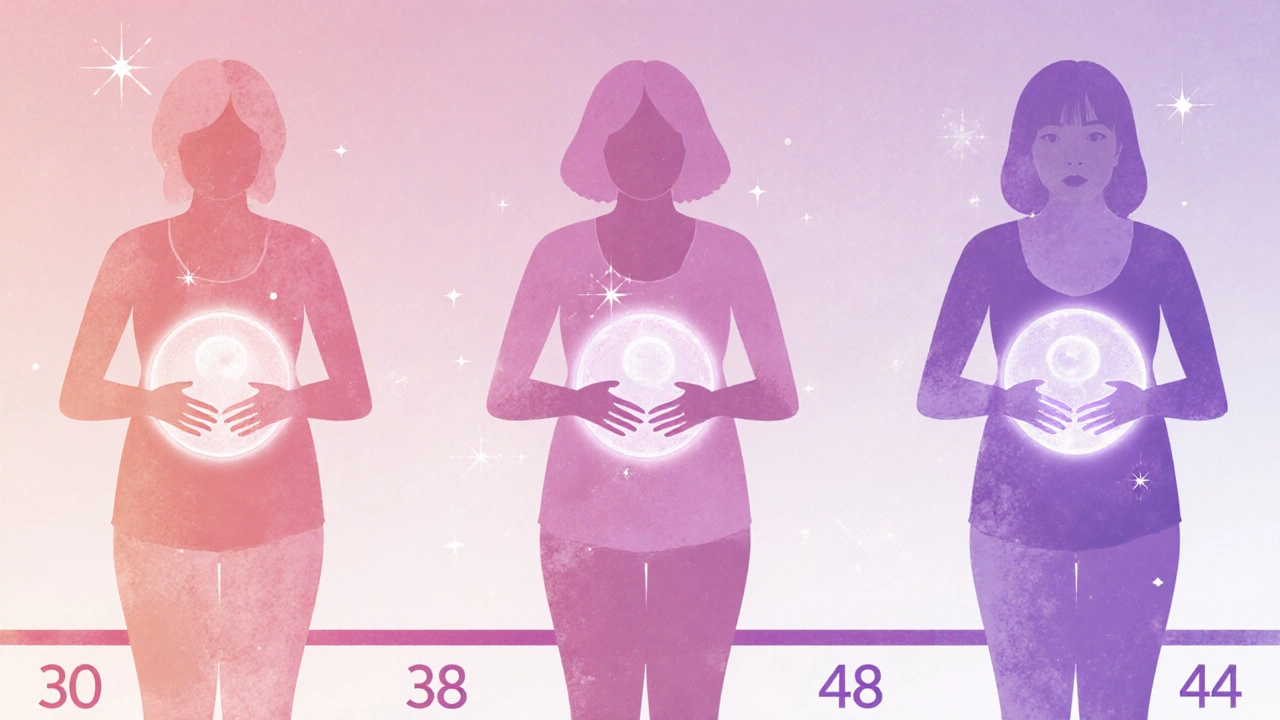IVF Success Rate Calculator
About IVF Success Rates
Success rates vary significantly based on age, cause of infertility, and treatment approach. Our calculator provides an estimate based on current medical data.
Important Note: These estimates are for informational purposes only. Individual results may vary. Consult with a fertility specialist for personalized advice.
When you hear the phrase “IVF guarantees a baby,” it feels like a promise you can’t refuse. The reality, however, is far more nuanced. IVF success rate isn’t a single number that works for everyone - it shifts with age, health, clinic expertise, and even the type of embryos transferred.
What Exactly Is IVF?
In vitro fertilisation (IVF) is a fertility treatment that combines a woman’s eggs with sperm outside the body, creating embryos that are later placed back into the uterus. It began in the late 1970s and has since helped millions of couples worldwide achieve parenthood.
How Do We Define Success?
In the IVF world, success can mean different things:
- Clinical pregnancy - a confirmed gestational sac on ultrasound.
- Live birth refers to a baby born after 24 weeks of gestation and is the metric most patients care about.
- Take‑home baby - the ultimate happy ending.
Most clinics publish numbers based on live‑birth rates per embryo transfer because that best reflects real‑world outcomes.
Global and Indian IVF Success Rates
According to the latest data from the Society for Assisted Reproductive Technology (SART) and the Indian Council of Medical Research (ICMR), the average live‑birth rate per fresh embryo transfer is roughly 30‑35% for women under 35, dropping to about 10‑15% for women in their early 40s.
In India, top‑tier fertility clinics report slightly higher numbers - around 38% for the 30‑34 age bracket - thanks to newer protocols and higher lab standards.

Age: The Most Powerful Predictor
Age is the single factor that influences IVF outcomes the most. Below is a quick snapshot of live‑birth rates by age group, based on pooled data from 2023‑2024 studies:
| Age Range | Live‑Birth Rate (%) | Typical Number of Cycles Needed for a Live Birth |
|---|---|---|
| Under 35 | 38 | Approximately 2‑3 cycles |
| 35‑37 | 31 | 3‑4 cycles |
| 38‑40 | 23 | 4‑5 cycles |
| 41‑42 | 14 | 6‑8 cycles |
| 43‑44 | 8 | 8‑10 cycles |
Notice how the success rate almost halves after 38. That’s why many experts advise women to consider IVF sooner rather than later.
Other Factors That Shift the Numbers
Beyond age, several variables can tip the scale:
- Cause of infertility - male factor, tubal disease, ovulatory disorders, or unexplained infertility each have distinct outcomes.
- Embryo quality - embryos graded as ‘top‑tier’ (often reached at the blastocyst stage) have higher implantation rates.
- Pre‑implantation genetic testing (PGT) - checking embryos for chromosomal abnormalities can improve live‑birth odds, especially for older women.
- Egg or sperm donor - donor gametes usually come from younger, healthier donors, boosting success.
- Clinic expertise - labs with higher success rates often have better incubation systems, stricter quality control, and experienced embryologists.
Why 100% Success Is Impossible
Even the most advanced clinics can’t guarantee a live birth for every cycle. Biological variability, genetic factors, and subtle uterine issues create inevitable loss points. Here are three common scenarios that break the “guarantee” myth:
- Implantation failure: A perfectly healthy embryo may not attach due to thin endometrium or immune factors.
- Chromosomal abnormalities: About 50% of embryos from women over 38 carry extra or missing chromosomes, leading to miscarriage.
- Technical mishaps: Lab contamination or freezing‑thawing damage, though rare, still happen.

Tips to Maximise Your Chances
While you can’t control every variable, you can optimize many of them:
- Start early - aim for IVF before 38 if possible.
- Maintain a healthy lifestyle - a BMI between 18‑25, balanced diet, and regular exercise improve outcomes.
- Choose a clinic with transparent data - look for published live‑birth rates per age group, not just overall percentages.
- Consider PGT if you’re over 35 or have recurrent miscarriage.
- Discuss the possibility of using donor eggs or sperm if your own gametes have low quality.
- Stay mentally healthy - stress reduction techniques have been linked to slightly higher implantation rates.
Next Steps After Reading This
Ready to turn curiosity into action? Here’s a short roadmap:
- Schedule a consultation with a reputable fertility specialist who can run a full work‑up (hormone profile, ultrasound, semen analysis).
- Ask for the clinic’s live‑birth statistics broken down by your age and diagnosis.
- Discuss whether a fresh or frozen embryo transfer suits your plan.
- Plan for emotional support - consider counseling or a support group.
- Budget realistically - factor in medication, monitoring, and possible extra cycles.
Remember, IVF is a journey, not a lottery ticket. Understanding the true numbers helps you set realistic expectations and make informed choices.
Frequently Asked Questions
What does a 30% IVF success rate actually mean?
It means that, on average, 30 out of 100 fresh embryo transfers will result in a live birth for the specific age and diagnosis group reported.
Can IVF guarantee a baby if I use donor eggs?
Donor eggs dramatically improve odds - live‑birth rates can climb to 55‑60% for women under 40 - but they still aren’t 100% guaranteed because implantation and uterine factors remain.
Is frozen embryo transfer (FET) as effective as a fresh transfer?
Recent studies show FET outcomes are comparable, and sometimes better, especially for older women, because the uterus can recover from stimulation before the embryo is placed.
How many IVF cycles should I plan for?
Statistically, most couples achieve a live birth within 3‑4 cycles if they start before 38. After 40, planning for 5‑6 cycles is realistic.
What are the biggest risks of IVF?
Risks include ovarian hyper‑stimulation syndrome (OHSS), multiple pregnancy, procedural complications, and emotional stress. Serious complications are rare (<1%).
